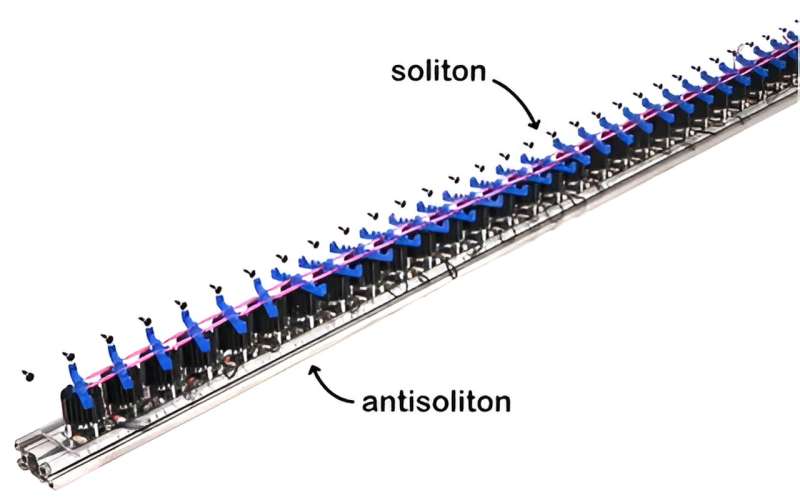This article has been reviewed according to Science X's editorial process and policies. Editors have highlighted the following attributes while ensuring the content's credibility:
fact-checked
peer-reviewed publication
trusted source
proofread
An endless domino effect: Non-reciprocal topological solitons in active metamaterials

Topological solitons can be found in many places and at many different length scales. For example, they take the form of kinks in coiled telephone cords and large molecules such as proteins. At a very different scale, a black hole can be understood as a topological soliton in the fabric of spacetime. Solitons play an important role in biological systems, being relevant for protein folding and morphogenesis—the development of cells or organs.
The unique features of topological solitons—that they can move around but always retain their shape and cannot suddenly disappear—are particularly interesting when combined with so-called non-reciprocal interactions. "In such an interaction, an agent A reacts to an agent B differently to the way agent B reacts to agent A," explains Jonas Veenstra, a Ph.D. student at the University of Amsterdam and first author of the new publication.
Veenstra continues, "Non-reciprocal interactions are commonplace in society and complex living systems but have long been overlooked by most physicists because they can only exist in a system out of equilibrium. By introducing non-reciprocal interactions in materials, we hope to blur the boundary between materials and machines and to create animate or lifelike materials."
The Machine Materials Laboratory, where Veenstra does his research, specializes in designing metamaterials: artificial materials and robotic systems that interact with their environment in a programmable fashion.
The research team decided to study the interplay between non-reciprocal interactions and topological solitons almost two years ago when then-students Anahita Sarvi and Chris Ventura Meinersen decided to follow up on their research project for the MSc course 'Academic Skills for Research.'
Solitons moving like dominoes
The soliton-hosting metamaterial developed by the researchers consists of a chain of rotating rods that are linked to each other by elastic bands. Each rod is mounted on a little motor which applies a small force to the rod, depending on how it is oriented with respect to its neighbors.
Importantly, the force applied depends on which side the neighbor is on, making the interactions between neighboring rods non-reciprocal. Finally, magnets on the rods are attracted by magnets placed next to the chain in such a way that each rod has two preferred positions, rotated either to the left or the right.
Solitons in this metamaterial are the locations where left- and right-rotated sections of the chain meet. The complementary boundaries between right- and left-rotated chain sections are then so-called 'anti-solitons'. This is analogous to kinks in an old-fashioned coiled telephone cord, where clockwise and anticlockwise-rotating sections of the cord meet.
When the motors in the chain are turned off, the solitons and anti-solitons can be manually pushed around in either direction. However, once the motors—and thereby the reciprocal interactions—are turned on, the solitons and anti-solitons automatically slide along the chain. They both move in the same direction, with a speed set by the anti-reciprocity imposed by the motors.
Veenstra says, "A lot of research has focused on moving topological solitons by applying external forces. In systems studied so far, solitons and anti-solitons were found to travel in opposite directions naturally. However, if you want to control the behavior of (anti-)solitons, you might want to drive them in the same direction."
"We discovered that non-reciprocal interactions achieve exactly this. The non-reciprocal forces are proportional to the rotation caused by the soliton, such that each soliton generates its own driving force."
The movement of the solitons is similar to a chain of dominoes falling, each one toppling its neighbor. However, unlike dominoes, the non-reciprocal interactions ensure that the 'toppling' can only happen in one direction.
And while dominoes can only fall down once, a soliton moving along the metamaterial simply sets up the chain for an anti-soliton to move through it in the same direction. In other words, any number of alternating solitons and anti-solitons can move through the chain without the need to 'reset.'
Motion control
Understanding the role of non-reciprocal driving will not only help us to better understand the behavior of topological solitons in living systems but can also lead to technological advances. The mechanism that generates the self-driving, one-directional solitons uncovered in this study can be used to control the motion of different types of waves (known as waveguiding) or to endow a metamaterial with a basic information processing capability such as filtering.
Future robots can also use topological solitons for basic robotic functionalities such as movement, sending out signals, and sensing their surroundings. These functionalities would then not be controlled from a central point but rather emerge from the sum of the robot's active parts.
All in all, the domino effect of solitons in metamaterials, now an interesting observation in the lab, may soon start to play a role in different branches of engineering and design.
The study is published in the journal Nature.
More information: Corentin Coulais, Non-reciprocal topological solitons in active metamaterials, Nature (2024). DOI: 10.1038/s41586-024-07097-6. www.nature.com/articles/s41586-024-07097-6
Journal information: Nature
Provided by University of Amsterdam





















